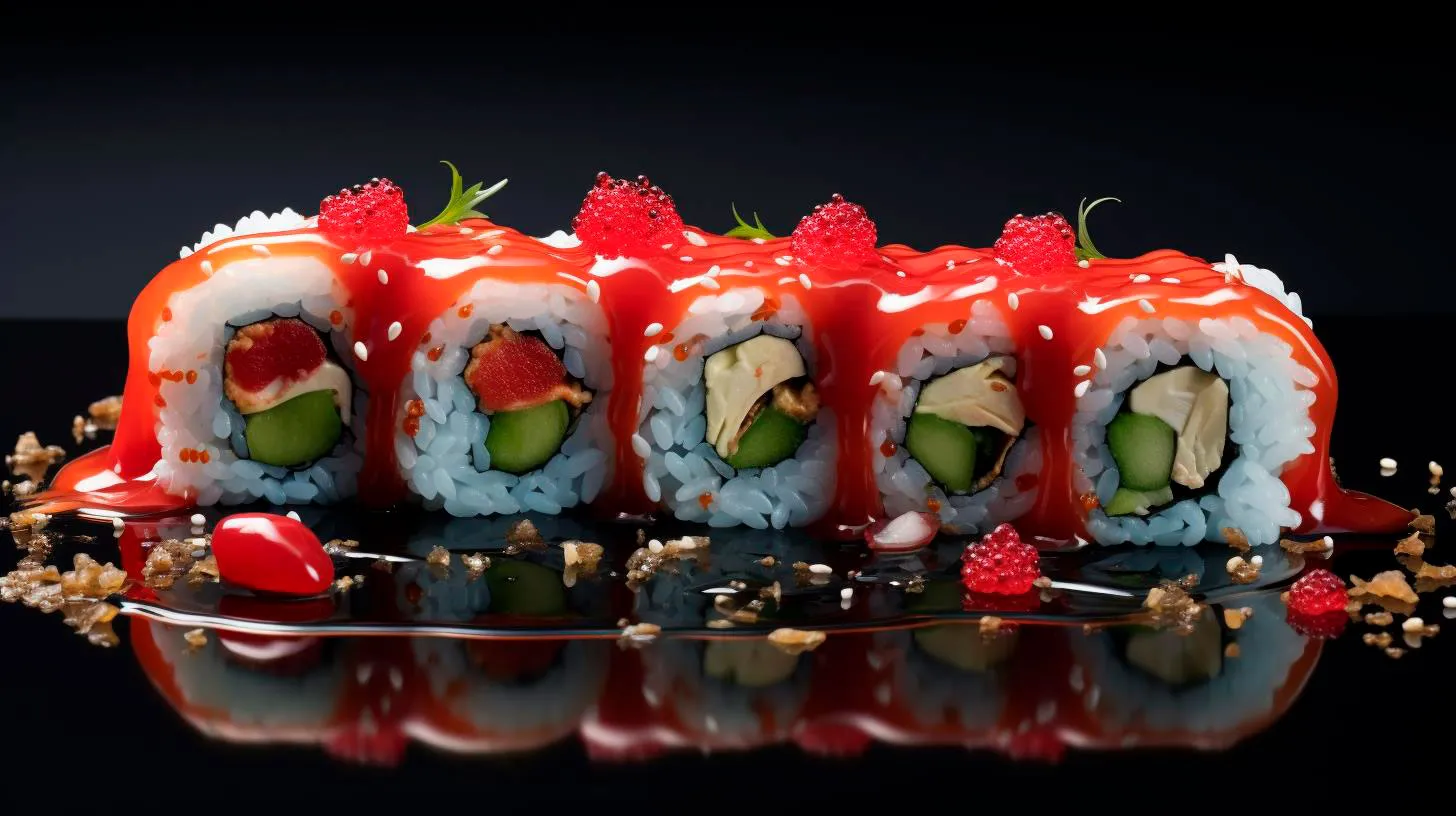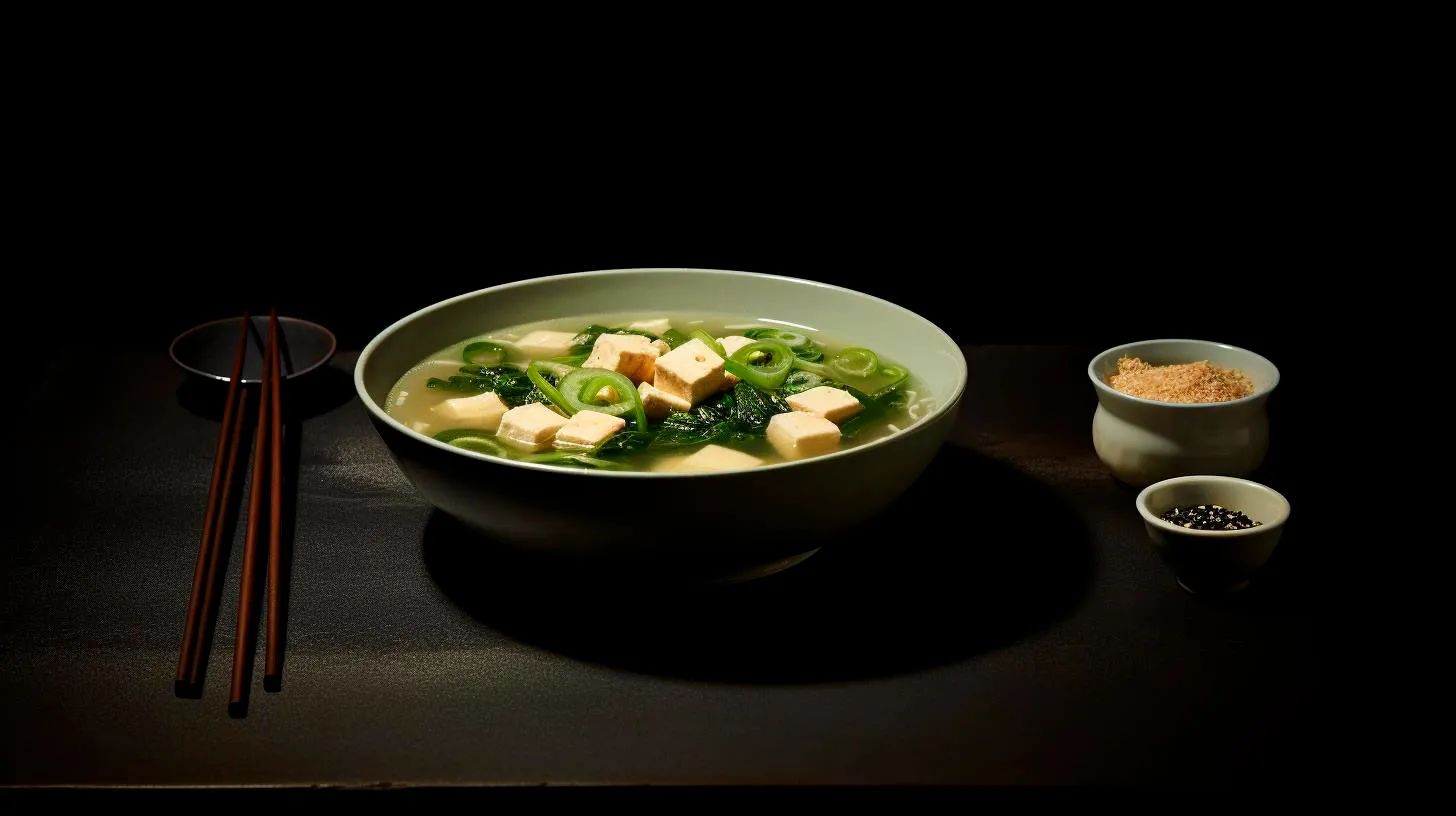Sushi Etiquette Worldwide: Discovering Cultural Contrasts
In this article, we will explore the diverse customs and traditions surrounding sushi consumption around the world.
The Art of Eating Sushi: Japan
Japan, the birthplace of sushi, is home to a rich and intricate sushi culture. When dining in a traditional sushi restaurant in Japan, there are several etiquettes to keep in mind:
- Customarily, one must never rub or overly dip the sushi into soy sauce. Instead, a small amount should be poured into a small dipping dish. Dip the fish side of the sushi gently into the sauce, ensuring it mixes appropriately without overpowering the taste.
- Using chopsticks is the preferred method for consuming sushi, although it is acceptable to use hands for nigiri sushi. However, if opting for fingers, remember to handle the sushi delicately and avoid turning it upside-down.
- As sushi is often served in bite-sized portions, it is polite to eat the entire piece in one go. Chewing with your mouth closed and refraining from making loud noises is also considered good manners.
Adhering to these customs can help you fully immerse yourself in the traditional Japanese sushi experience, allowing you to appreciate the artistry and flavors the dish has to offer.
Sushi Etiquette in Western Countries
As sushi gained popularity in Western countries, it inevitably underwent some adaptation to suit local tastes and customs. Here are a few key etiquette practices followed in Western sushi restaurants:
- While chopsticks are usually provided, it is generally acceptable to use hands to consume sushi.
- In Western countries, it is customary to generously dip the sushi into soy sauce. However, be mindful not to soak the rice, as it may cause the sushi to fall apart.
- Unlike the Japanese tradition, dividing sushi into smaller pieces is more common in Western countries. It is acceptable to bite into a sushi roll or cut it into halves or quarters, depending on its size.
Embracing these adaptations allows individuals in Western countries to enjoy sushi while respecting their own cultural norms and preferences.
Sushi Etiquette Across the Globe
As sushi continues to captivate taste buds worldwide, let’s take a look at some unique sushi customs from various countries:
Brazil
In Brazil, sushi enthusiasts can enjoy a fusion of Japanese and Brazilian influences. Here are a few peculiarities of sushi etiquette in Brazil:
- Spicy mayo and cream cheese are common toppings for sushi rolls in Brazil, catering to local palates.
- It is acceptable to eat sushi with hands or chopsticks, depending on personal preference.
Thailand
Thai sushi customs uphold their vibrant culinary traditions while embracing sushi’s nuances. Here are a few highlights:
- Thai sushi often incorporates ingredients such as chili, basil, and lemongrass, adding a spicy and tangy twist.
- It is customary to garnish sushi with herbs or dipping sauces, enhancing the flavor profile.
Hawaii
Hawaiian sushi, known as “sushi roll” or “maki sushi,” has its own set of customs:
- Hawaiian sushi often includes tropical ingredients like pineapple, mango, and macadamia nuts, giving it a unique island flavor.
- Sushi rolls are often prepared with seaweed on the outside rather than the traditional inside-out rolls.
Key Takeaways
Understanding sushi etiquette allows us to fully appreciate and immerse ourselves in the cultural experience of this beloved food. Here are some key takeaways:
- Sushi etiquette varies from country to country, reflecting cultural nuances and local preferences.
- When dining in a traditional Japanese sushi restaurant, using chopsticks and minimal soy sauce is the norm.
- Adapting sushi etiquette in Western countries, including using hands and generous soy sauce dipping, accommodates local customs.
- Sushi customs around the globe showcase unique and delicious cultural blends.
By respecting these customs, we can indulge in sushi not only as a culinary delight but also as a way to embrace and appreciate different cultures around the world. So next time you enjoy sushi, remember to savor not only the flavors but also the diverse traditions that accompany this beloved dish.
Exploring Sushi Customs: A Cultural Journey Beyond Japan
Today, we embark on a cultural journey beyond Japan, exploring the customs and significance of sushi in different parts of the world.
Sushi: A Celebration of Freshness and Artistry
Originating in Japan, sushi has been perfected for centuries and has now become a global sensation. The process of making sushi is no less than an art form, with skilled chefs meticulously selecting the finest ingredients and gracing each piece with precision and creativity.
Key takeaways:
- The art of sushi-making requires skill, precision, and creativity.
- Meticulously selected fresh ingredients contribute to the flavors and textures of sushi.
- Sushi chefs dedicate years to master the art of crafting sushi.
The Role of Freshness and Quality
One of the primary customs associated with sushi is the emphasis on freshness and quality. In Japan, it is believed that the taste and nutritional value of sushi largely depends on the freshness of the ingredients. This belief has made sushi restaurants in Japan renowned for their dedication to sourcing top-notch ingredients directly from local markets.
Advantages of emphasizing freshness and quality:
- Enhanced taste and texture of sushi.
- Increased nutritional value of the dish.
- Supporting local markets and sustainable fishing practices.
Regional Influences on Sushi
As sushi has gained popularity worldwide, it has also been influenced by local tastes and preferences. Each region has added its own unique touch to sushi, making it a delightful fusion of flavors and styles.
Regional influences and key takeaways:
-
American-style sushi:
- Introduced the concept of “California Roll” with ingredients like avocado and crab.
- Popularized sushi as a trendy and accessible food option.
- Experimentation with ingredients and flavors, creating unique local variations.
-
Brazilian-style sushi:
- Incorporated vibrant flavors through the use of tropical fruits and spicy sauces.
- Introduced the concept of sushi buffet, appealing to a wider audience.
- Combining sushi with traditional Brazilian cuisine, such as feijoada.
-
Fusion sushi:
- Blend of Japanese tradition with flavors from other cuisines, like Mexican or Thai.
- Offers a diverse range of options to suit various palates.
- Creative presentation and use of unique ingredients to create innovative rolls.
The Importance of Sushi Etiquette
Respecting sushi customs also involves adhering to proper sushi etiquette. In Japan, certain rules govern the consumption of sushi to ensure a respectful and enjoyable dining experience.
Key etiquette rules:
- Eating sushi in one bite to fully appreciate the combination of flavors.
- Using chopsticks or fingers (depending on the type of sushi) to pick up and eat sushi.
- Avoiding excessive soy sauce and wasabi, as it may overpower the delicate flavors of sushi.
- Showing appreciation to the sushi chef by saying “arigato gozaimasu” (thank you) after the meal.
Sushi’s Global Impact
With the globalization of sushi, people from different cultures have come to appreciate and enjoy this delectable dish. Its widespread popularity has led to a significant impact on various aspects:
Global impact of sushi:
- Increase in international seafood trade due to the high demand for sushi ingredients.
- Boost in tourism to Japan, driven by the desire to experience authentic sushi.
- The rise of sushi chefs worldwide, contributing to cultural exchange and employment opportunities.
- Integration of sushi into local culinary scenes, creating fusion cuisines and culinary innovations.
As you delve into the world of sushi customs, remember that it is not just a culinary delight but also a representation of culture, tradition, and creativity. The next time you savor a piece of sushi, appreciate the customs behind it and the journey it has made from Japan to your plate.
From Tokyo to New York: Unveiling the Diverse Sushi Dining Traditions
The Sushi Culture in Tokyo
Tokyo, the capital city of Japan, is renowned for its vibrant sushi scene. Whether you’re a sushi connoisseur or a curious traveler, indulging in this cultural experience is a must. Here are some key aspects of the sushi culture in Tokyo:
- Diversity of Sushi Styles: Tokyo offers a wide variety of sushi styles, including nigiri, maki, and sashimi. Each style has its unique preparation method and flavor profile, ensuring an incredible culinary adventure.
- Omakase: A popular dining style in Tokyo, omakase allows the chef to choose the best ingredients and create a personalized menu for the guests. This sushi experience showcases the skill and creativity of the sushi chef.
- Seasonal Ingredients: Tokyo’s sushi chefs prioritize fresh, seasonal ingredients. With Japan’s rich seafood resources, you can expect an extensive selection of fish and seafood in its sushi bars.
- Traditional Etiquette: Tokyo’s sushi bars adhere to certain traditional customs, such as not using too much soy sauce, eating sushi in one bite, and refraining from adding wasabi to soy sauce before tasting the sushi.
With its attention to detail and focus on flavor, Tokyo sets the benchmark for sushi traditions worldwide.
The Sushi Scene in New York
New York City, the melting pot of cultures, has its own bustling sushi scene. In this cosmopolitan city, sushi has seamlessly integrated with local preferences to create a unique dining experience. Let’s explore the distinct characteristics of sushi in New York:
- Fusion Creations: New York excels in fusion cuisine, and sushi is no exception. Here, you’ll find innovative sushi creations that blend traditional Japanese flavors with local ingredients, such as the famous avocado or cream cheese-filled rolls.
- All-you-can-eat Sushi: A popular trend in New York, all-you-can-eat sushi establishments offer customers a chance to indulge in unlimited sushi at a fixed price. This approach appeals to sushi lovers with big appetites and budget-conscious diners.
- Quick and Convenient: For the fast-paced New York lifestyle, sushi takeout and delivery services are widely available. This allows busy New Yorkers to savor their favorite sushi anytime, anywhere.
- Modern Sushi Bars: New York’s sushi bars are often trendy, stylish, and create a lively ambiance for guests. Alongside traditional sushi chefs, you’ll also find modern sushi concepts with interactive experiences like conveyor belts.
New York’s sushi scene embraces creativity and adaptability, reflecting the city’s dynamic culinary landscape.
The Key Takeaways
Comparing Tokyo and New York’s sushi dining traditions reveals the diversity and adaptability of this beloved cuisine. Here are the key takeaways:
- Cultural Significance: Sushi is not merely a meal but a representation of culture and tradition. It highlights the culinary heritage of Japan in Tokyo and showcases the fusion of flavors in New York.
- Flavor Exploration: Both cities offer an array of flavors and styles that cater to diverse taste preferences. Whether you seek traditional elegance or bold experimentation, you can find it in the sushi bars of Tokyo and New York.
- Artistry and Presentation: Sushi is an art form that delights visually as much as it pleases the palate. From the meticulous preparation in Tokyo to the creative plating in New York, sushi is a feast for the senses.
- Global Appreciation: Sushi’s worldwide popularity demonstrates its ability to transcend cultural boundaries. People from all corners of the globe now have the opportunity to indulge in this culinary delight.
So, whether you find yourself in the traditional sushi temples of Tokyo or enjoying the innovation and culinary fusion in New York City, one thing is certain – sushi will continue to captivate food lovers around the world.
Sushi Etiquette: Japan’s Traditional Customs and Beyond
So, let’s delve into the intriguing world of sushi etiquette!
Understanding Sushi Etiquette
Just like any other country, Japan has its own set of etiquette rules when it comes to consuming sushi. Adhering to these customs not only shows respect for the sushi chef but also allows you to fully immerse yourself in the cultural experience. Here are some key points to keep in mind:
1. Greeting the Chef
- Upon entering a traditional sushi restaurant, it is customary to greet the chef with a polite “Irasshaimase!” (Welcome!).
- Respectfully wait for the chef to acknowledge your presence before taking your seat.
2. Using Chopsticks
- When eating sushi, it is common to use chopsticks instead of your hands.
- Remember not to rub your chopsticks together as it implies that they are of low quality.
3. Eating Wasabi
- While sushi is typically served with a small amount of wasabi between the fish and the rice, it is considered impolite to mix it in soy sauce.
- If you prefer a spicier flavor, you can dab a small amount of wasabi on the fish itself.
4. Dipping Sushi in Soy Sauce
- When dipping your sushi in soy sauce, do it lightly and ensure that only the fish touches the soy sauce.
- Avoid submerging the rice in soy sauce, as it can cause the sushi to become overly salty or fall apart.
5. Eating Sushi in One Bite
- It is considered proper etiquette to eat sushi in one bite.
- By doing so, you can fully appreciate the harmony of flavors from the carefully crafted combination of ingredients.
6. Appreciating Each Piece
- Take a moment to savor the flavor of each sushi piece before moving on to the next.
- This allows you to fully appreciate the craftsmanship and expertise that went into its preparation.
7. Showing Appreciation
- At the end of your meal, it is customary to express your gratitude by saying “Gochisousama deshita” (Thank you for the meal).
- This gesture shows respect for the chef’s skill and effort.
The Advantages of Following Sushi Etiquette
Now that we understand the basic sushi etiquette, let’s explore some of the advantages it brings:
1. Enhanced Dining Experience
By adhering to sushi etiquette, you can enhance your overall dining experience. It allows you to immerse yourself in Japan’s culinary traditions and fully appreciate the artistry that goes into making each sushi piece.
2. Respect for the Sushi Chef
Sushi chefs devote years to perfecting their craft. By following the etiquette, you demonstrate your respect for their work and dedication. This acknowledgement can foster a positive relationship between you and the chef.
3. Cultural Awareness
Understanding and respecting sushi etiquette showcases your cultural awareness and appreciation for Japanese traditions. It shows that you are not only interested in the cuisine but also the customs and traditions associated with it.
Key Takeaways
Sushi etiquette forms an integral part of Japanese culinary culture. By following these customs, you can enhance your dining experience and demonstrate respect for the sushi chef’s skill and dedication. Here are some key takeaways:
- Greet the chef with “Irasshaimase!” upon entering a restaurant.
- Use chopsticks to eat sushi, avoiding rubbing them together.
- Avoid mixing wasabi in soy sauce; instead, apply it directly on the fish.
- Dip sushi lightly in soy sauce, ensuring only the fish touches it.
- Eat sushi in one bite to fully appreciate the flavors.
- Take time to savor each piece and express gratitude at the end with “Gochisousama deshita.”
By immersing ourselves in sushi etiquette, we can truly embrace the rich cultural heritage that accompanies this beloved Japanese cuisine.


